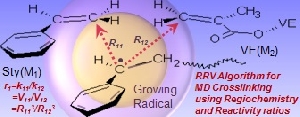Publications at the HPC²
Publication Abstract
Relative Reactivity Volume Criterion for Crosslinking: Application to Vinyl Ester Resin Molecular Dynamics Simulations
Jang, C., Lacy, T., Gwaltney, S. R., Toghiani, H., & Pittman, C. (2012). Relative Reactivity Volume Criterion for Crosslinking: Application to Vinyl Ester Resin Molecular Dynamics Simulations. Macromolecules. 45(11), 4876-4885. DOI:10.1021/ma202754d.
Molecular dynamics simulations were performed to create a series of crosslinked vinyl ester resins. The crosslink density was varied at constant conversion. Thermodynamic and mechanical properties were calculated as a function of the crosslink density. A new relative reactivity volume (RRV) algorithm was developed to generate the crosslinking network by incorporating the correct regioselectivity (head-to-tail chain propagation), and monomer reactivity ratios. This is the first application of reactivity ratios for free radical addition polymerization in MD simulations. Prior crosslinking simulations were performed on step-growth epoxy resin curing. Vinyl esters studied here cure by free radical addition copolymerization. Crosslinked networks with double bond conversions up to 98% were achieved. Volume shrinkage, glass transition temperatures, and tensile elastic constants were calculated. Predicted Young’s moduli were compared with experimental data. This RRV method can generate other thermoset and thermoplastic systems containing different monomers, and provide an approach for handling simultaneous irreversible reactions in MD simulations.

